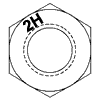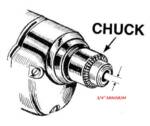Newest FAQs
Stamping the heads of F1554 anchor bolts is not required per the ASTM Specification, but Portland Bolt chooses to do so to provide a secondary identification. Product Marking ASTM F1554 anchor bolts are marked on the threaded end that projects from the concrete with a designating color code, as is required by the specification. Marking... Read more
Proof strength, or proof load, is the full size equivalent of a yield test. Yield testing is typically only performed on machined specimens. In most fastener standards, full size testing is the preferred method, and the referee method if there is a discrepancy between the two test results. Because of the difficulty of getting reliable... Read more

There is no published requirement for making sure the ID marks are on the outside and visible. The main concern would be being able to ascertain that the proper nuts were installed. If all the ID markings are on the inside, they would not be visible, and an inspector could not see them. That said,... Read more

Yes, A325-3 and A490-3 are made from weathering steel containing copper, chromium, and nickel which induces the surface to form a heavy oxide coating that protects the base material from corroding any further. This brownish-red coating seals the material from corrosion much like other external coating options. These types of bolts are more often used... Read more
Portland Bolt does not have the ability to load cargo containers for ocean freight. We have no experience in securing the contents inside so this will have to be done by a freight forwarder. We routinely load our shipments on a truck at our facility where they are sent to be loaded in a container... Read more
A tap bolt is (typically) a fully threaded hex bolt, while a cap screw is (typically) a hex head bolt that will be installed by turning the head of the bolt (screw) instead of tightening it with a nut. Usually cap screws are being threaded into something (a piece of machinery for example), rather than... Read more
Both the shear plate dapping tool and the split ring grooving tool require a heavy duty drill or drill press with a 3/4” minimum chuck size. Many of the small, cordless drills on the market only have a 3/8” or 1/2” chuck and would not be able to open their chuck wide enough to accept... Read more

Your page says A320 requires bolts or cap screws to have heavy hex heads. I have the 2003 edition of A320 and can’t find that requirement. Where is that requirement stated? The ASTM A320 specification does not specifically address the physical dimensions of headed bolts. However, it does refer you to ASTM A962 for some... Read more
It not uncommon for us to get requests or for bolt configurations that don’t match the specifications. Anchor bolts called out as headed Grade 8 bolts are only available with a hex head. From your description ASTM A354 BD would be the correct fastener. This specification has mechanical properties that are very similar to SAE... Read more
We do not recommend allowing this type of substitution without approval from the Engineer of Record. Based on performing mechanical tests to the ASTM specification F606 which covers the testing of construction fasteners, a rod with a nut would typically not produce the same strength characteristics as a bolt with a forged head. Under F606,... Read more
